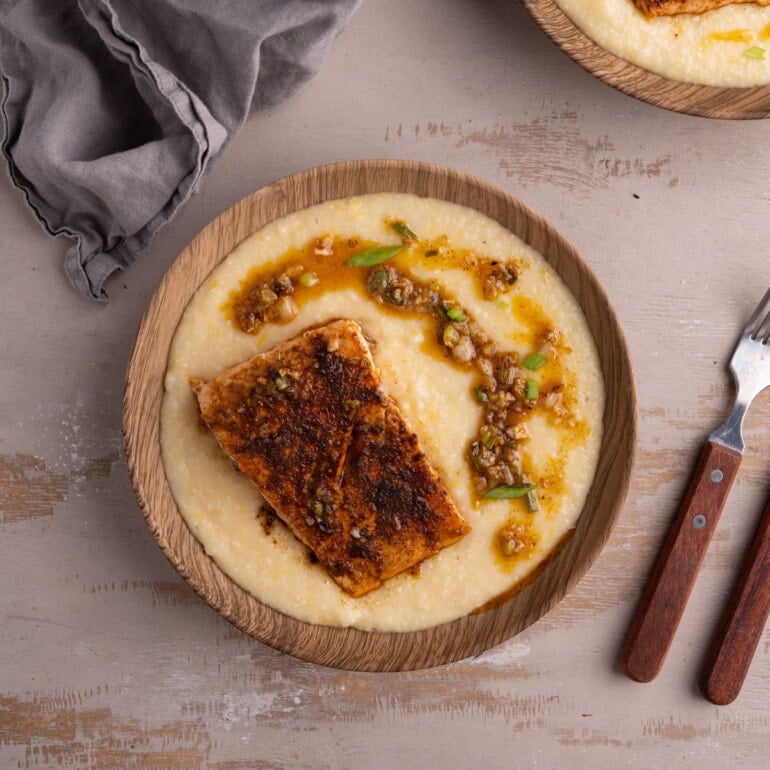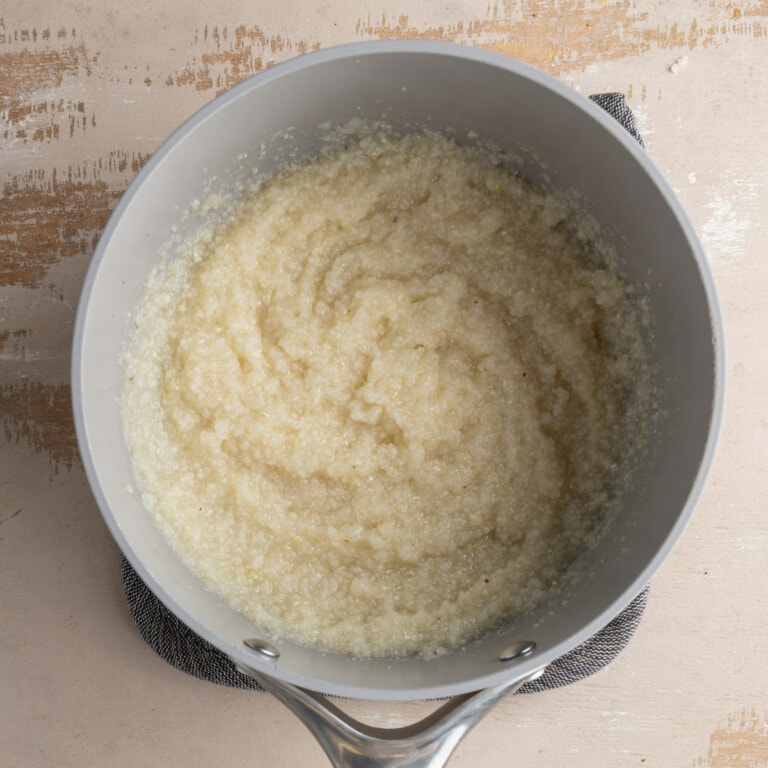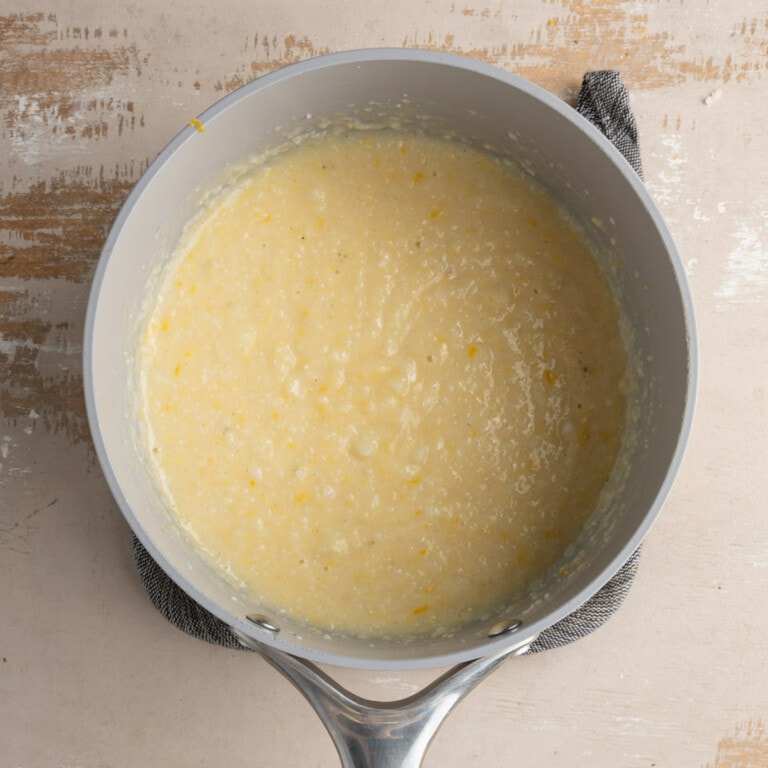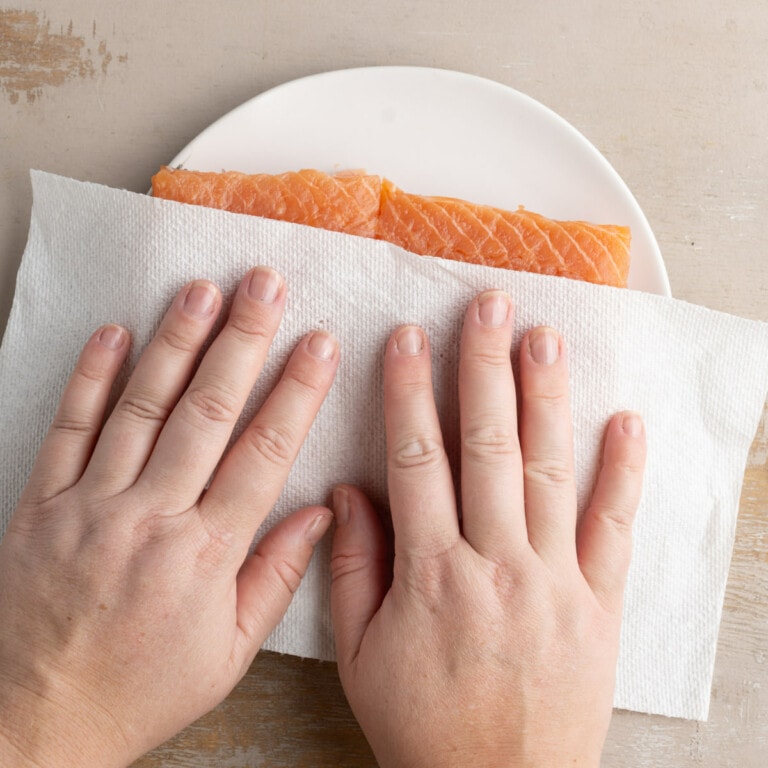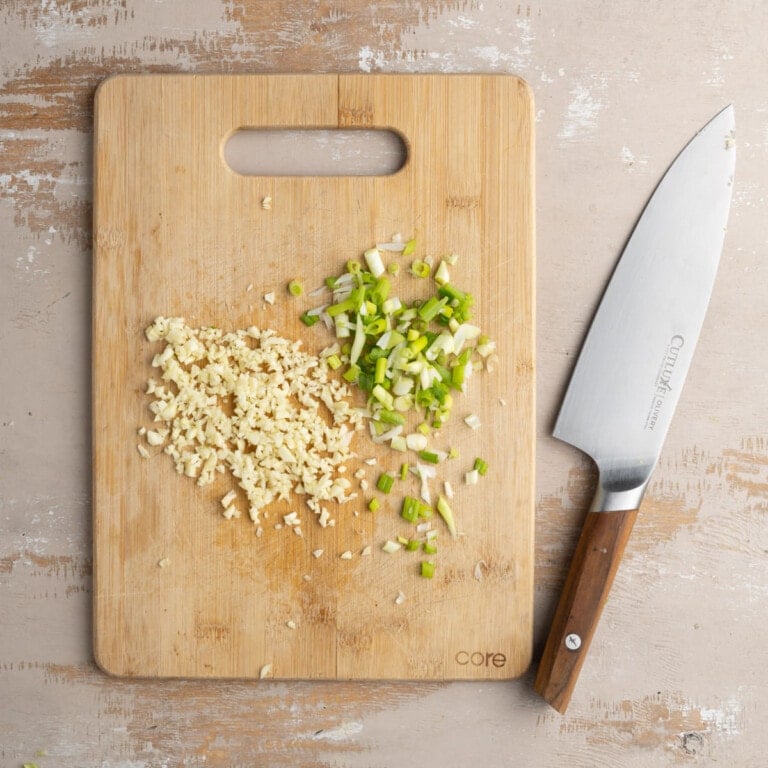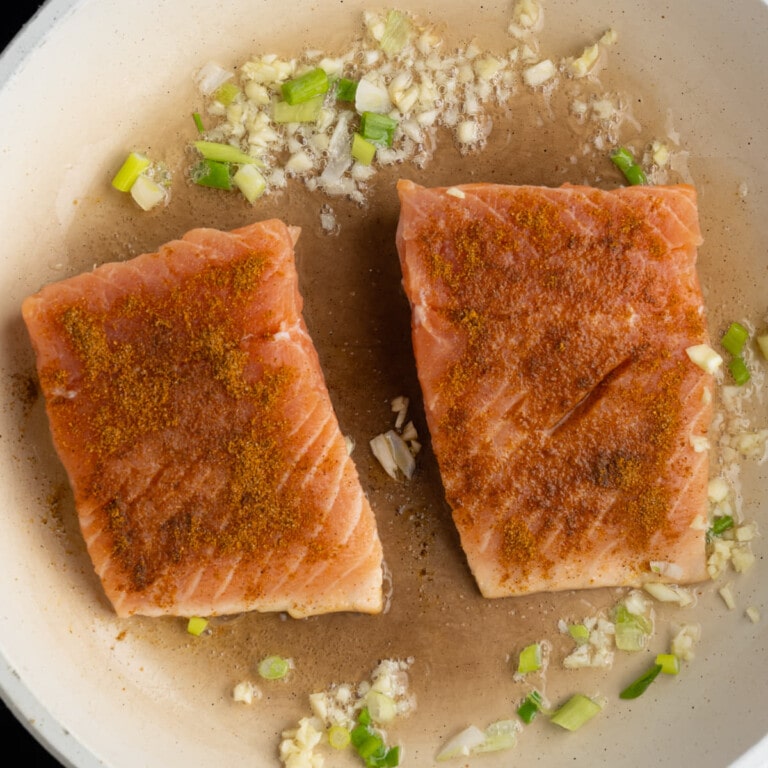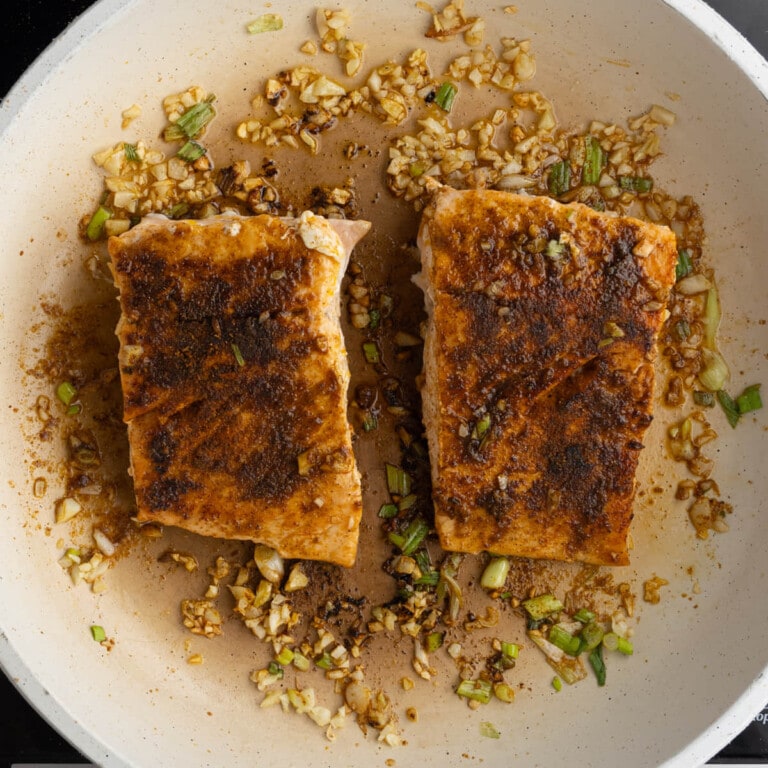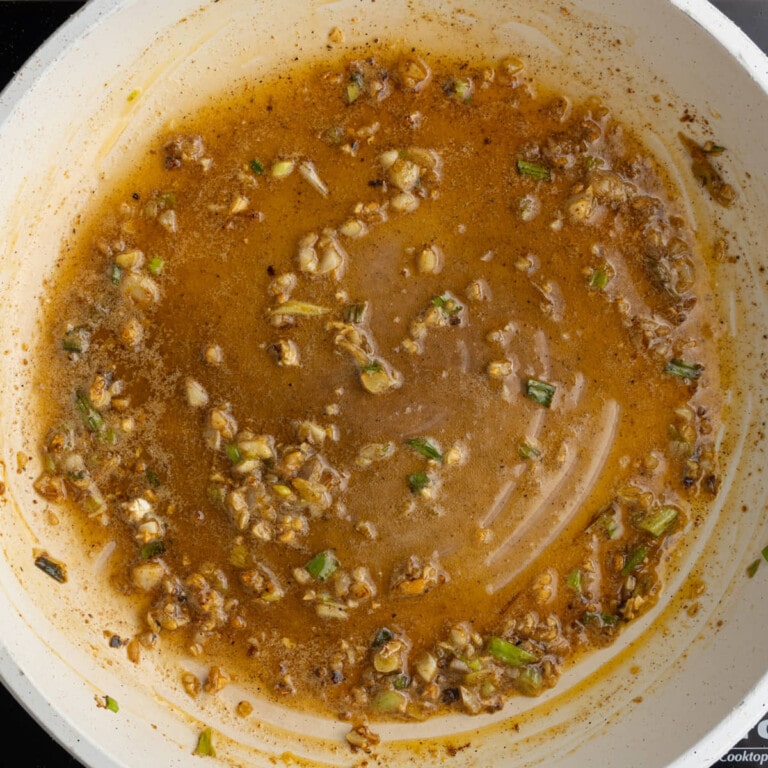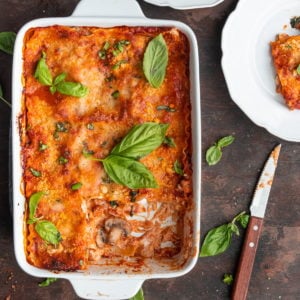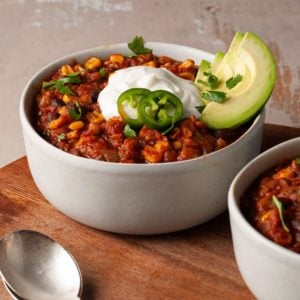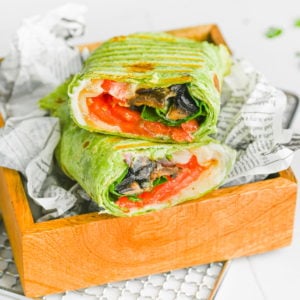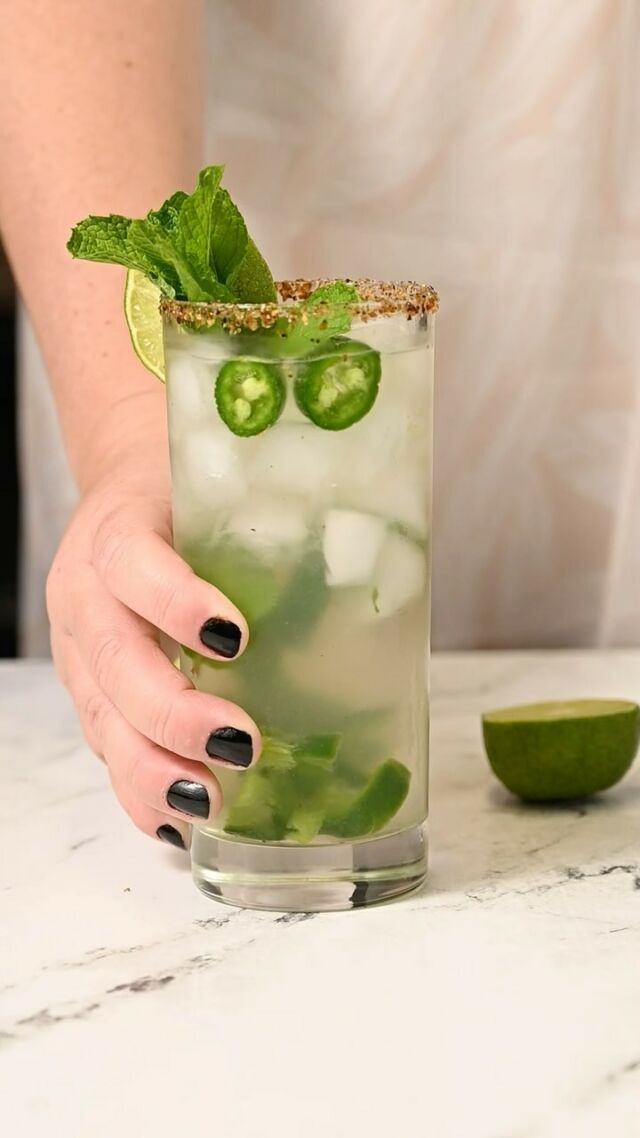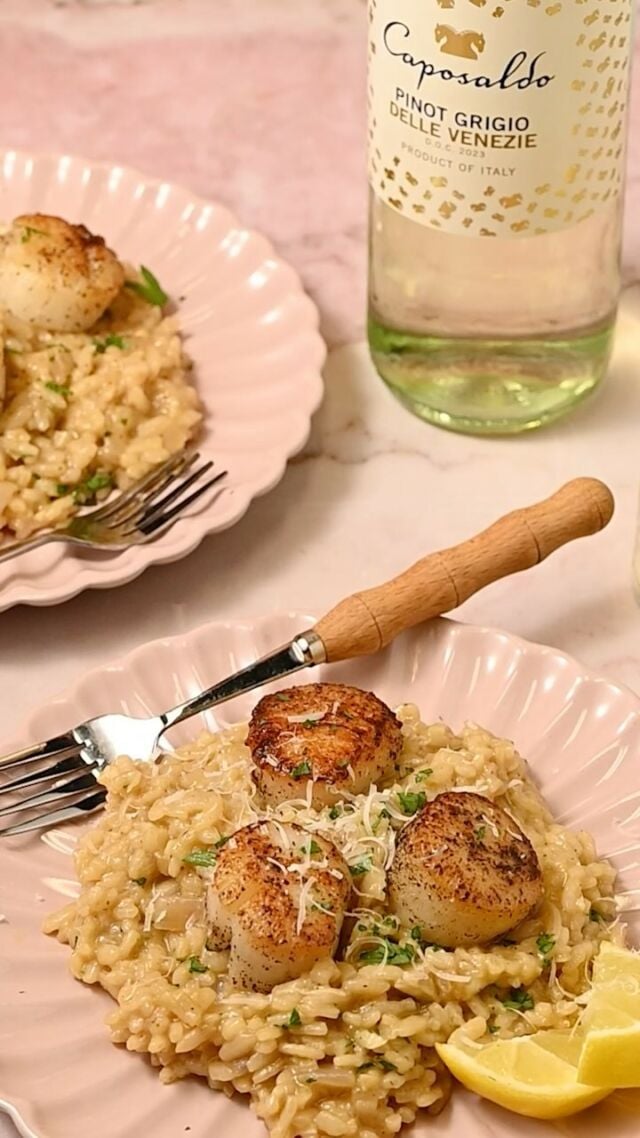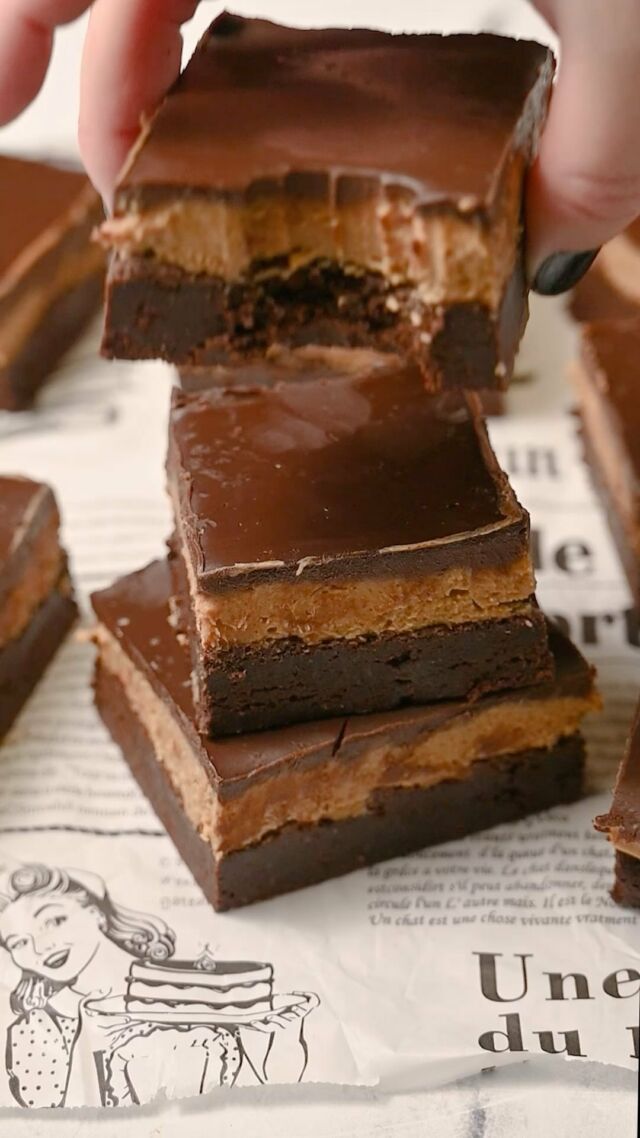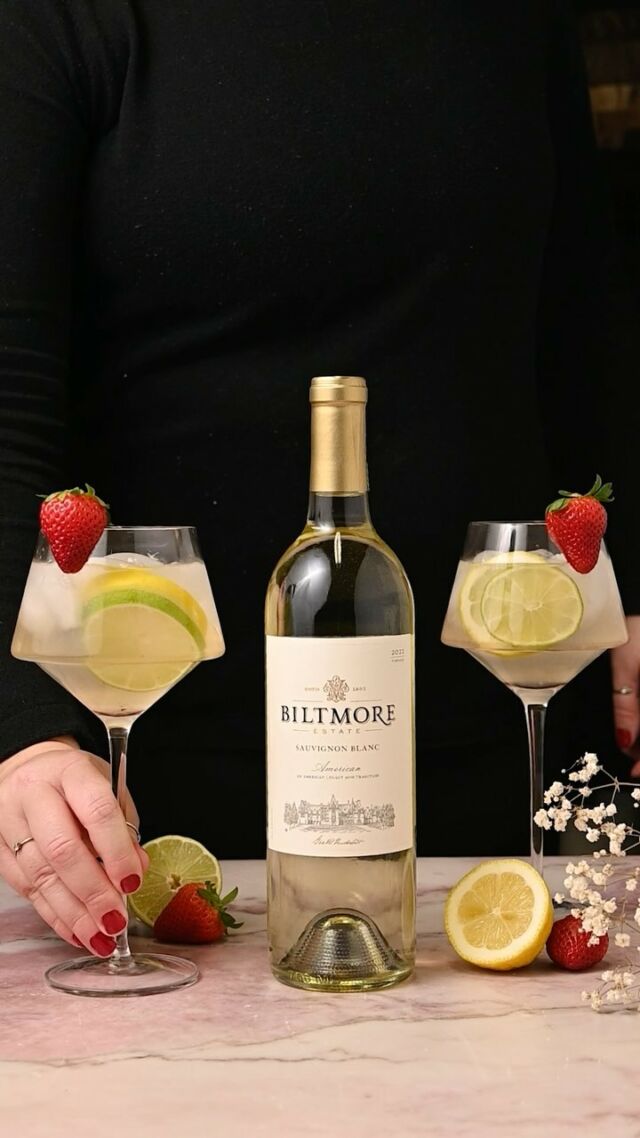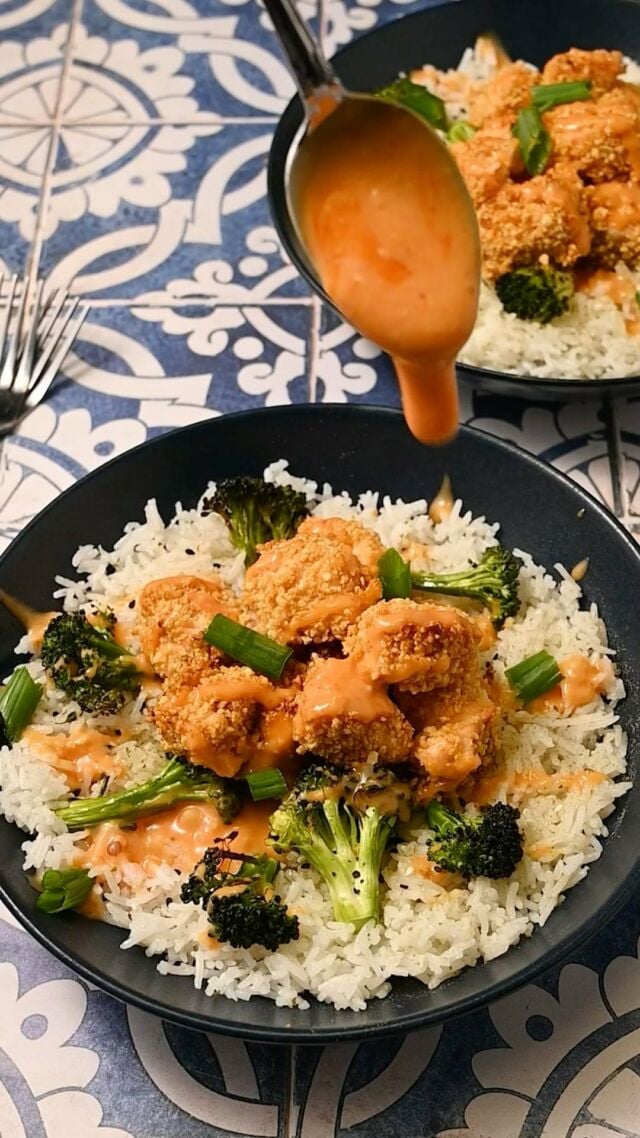Craving a meal that’s both indulgently rich and wonderfully comforting? These Creamy Cajun Salmon and Grits are a delectable harmony of pan-fried Cajun salmon and velvety grits that’ll transport your taste buds straight to the heart of the South!
This boldly flavored fish and grits recipe is quick and easy to make and requires just 11 ingredients. The spice on the salmon is well-balanced by the creamy grits culminating in a truly flawless fish-centric dish. All this and more will make this southern-style dish a family fave when it comes to 30-minute meal ideas.
In this skinless salmon recipe, you will learn how to make foolproof creamy grits, how to pan-fry Cajun-style salmon, and how to deglaze the pan with butter for a delicious finishing sauce.
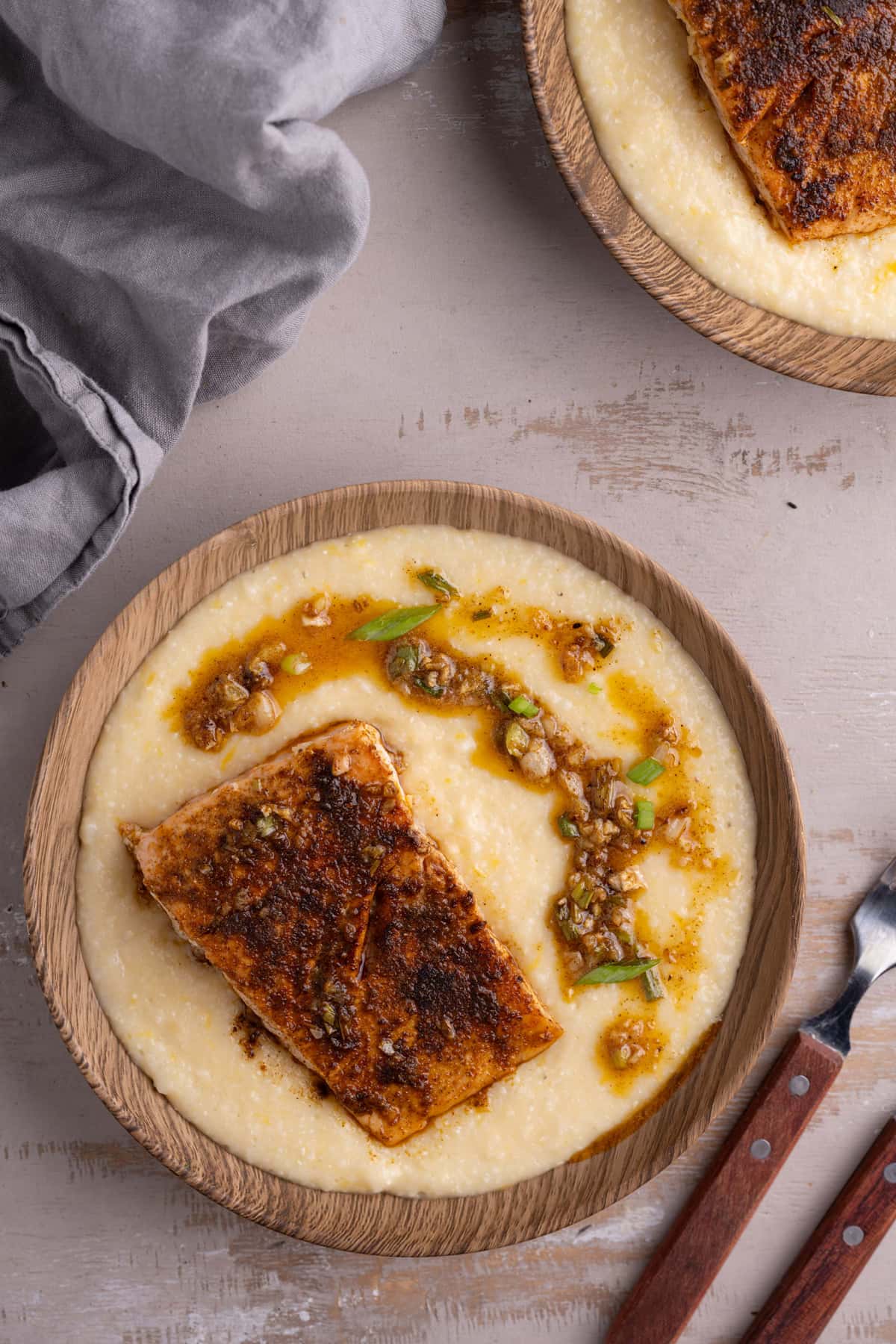
Salmon and Grits Ingredients
Here’s everything you need:
- Quick grits. Or stone-ground or Old-Fashioned grits. I use quick grits, mostly because they’re more widely available and easier to find, but also because it helps me get this meal on the table fast. If you prefer stoneground or Old Fashioned grits, they absolutely work in this recipe, too. You will just need to leave them over the heat a little bit longer.
- Vegetable broth. You can buy it at the store or make your own vegetable broth. Chicken broth works here, too.
- Milk. Any milk will do. You can use anything from skim to whole dairy milk, or even any unsweetened, unflavored non-dairy milk.
- Cheddar cheese. You can buy pre-shredded for ease and convenience, but if you want the best of the best quality and flavor, grate your own cheddar! I used sharp but choose any cheddar from mild to sharp depending on your preference.
- Olive oil.
- Salmon. I used fresh salmon. If you’re using frozen salmon, make sure to allow it to thaw overnight in the refrigerator or add it to a bag and submerge the bag in room temperature water for about 45 minutes to defrost before using it for this skinless salmon recipe. You can buy it skinless or remove the skin yourself.
- Scallions. For deep flavor and some color.
- Garlic.
- Lemon juice. A little citrus goes a long way on the salmon.
- Cajun seasoning. Use your favorite! Or make your own. If you’re not a big fan of spice, you can use Old Bay Seasoning instead.
- Unsalted butter. To deglaze the pan after cooking the salmon to make a delicious buttery sauce to pour over the salmon and grits.
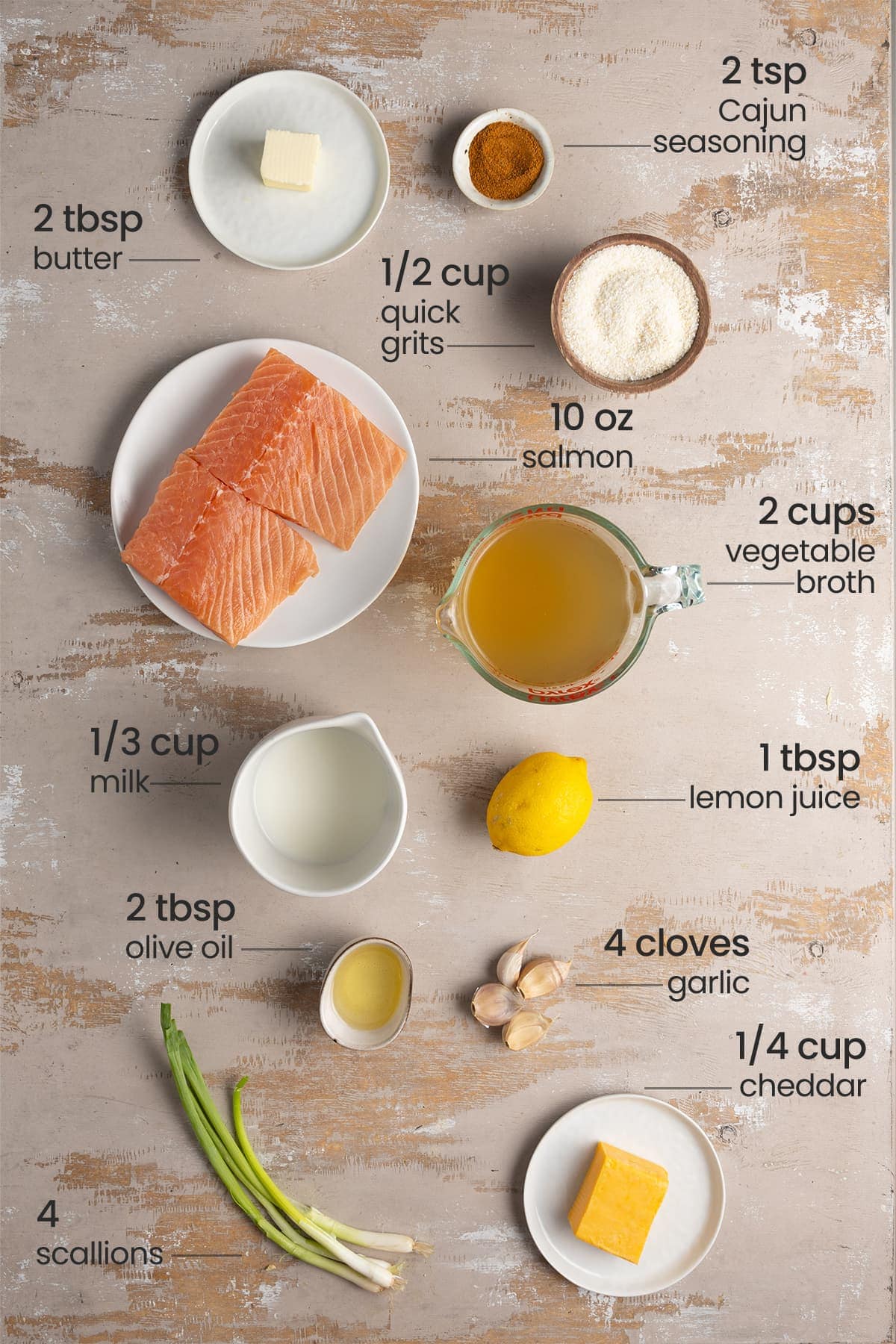
Sustainable Salmon
Raising salmon in farms (the main way consumers buy salmon) can harm the environment in a number of ways.
The antibiotics given to the farmed salmon can end up polluting the water surrounding the farms. Additionally, catching fish to feed the farmed salmon can also diminish other fish populations.
On the flip side, catching wild salmon has its own set of problems, like accidentally catching other animals and species of fish, a phenomenon referred to as bycatch. Plus, it can be hard to find wild-caught salmon to purchase (not to mention expensive!).
So, all that being said, how can we make sure we’re getting salmon in a way that’s good for the environment?
In the U.S., we have two good options: buying wild-caught Alaskan salmon or sustainably farmed salmon.
Green tip: Look for Marine Stewardship Council and Friend of the Sea labels on your fish to ensure they were harvested sustainably.
Salmon and Grits Tips and Tricks
How to Prep Salmon for Searing in a Pan
After much debate and recipe testing, I’ve decided to go with skinless salmon for this recipe. While you absolutely can consume the skin, flaky skinless salmon is a better match for serving over the creamy grits.
You can buy your salmon skinless, or you can remove the skin on your own. Check out this video about how to remove salmon skin for the quickest and easiest technique.
Once you’ve removed the salmon skin, I highly recommend saving it to make this Crispy Salmon Skin. They’re delicious and nutritious and will help you avoid waste!
Once the skin is removed, use paper towels to pat the salmon dry. Removing the excess moisture will give you an overall crispier salmon. This is the same pat dry technique I use in my ever-popular Almond Crusted Salmon.
Green tip: Paper products contribute to deforestation. Consider these bamboo paper towels! Bamboo naturally regenerates every few months, whereas trees cannot regrow once harvested.
At this point, if you have a larger cut of salmon, you’ll want to slice it into two individual portions. A typical portion of salmon is anywhere from 3-5 ounces.
I had a 10-ounce piece of skinless salmon and sliced it into to 5-ounce portions.
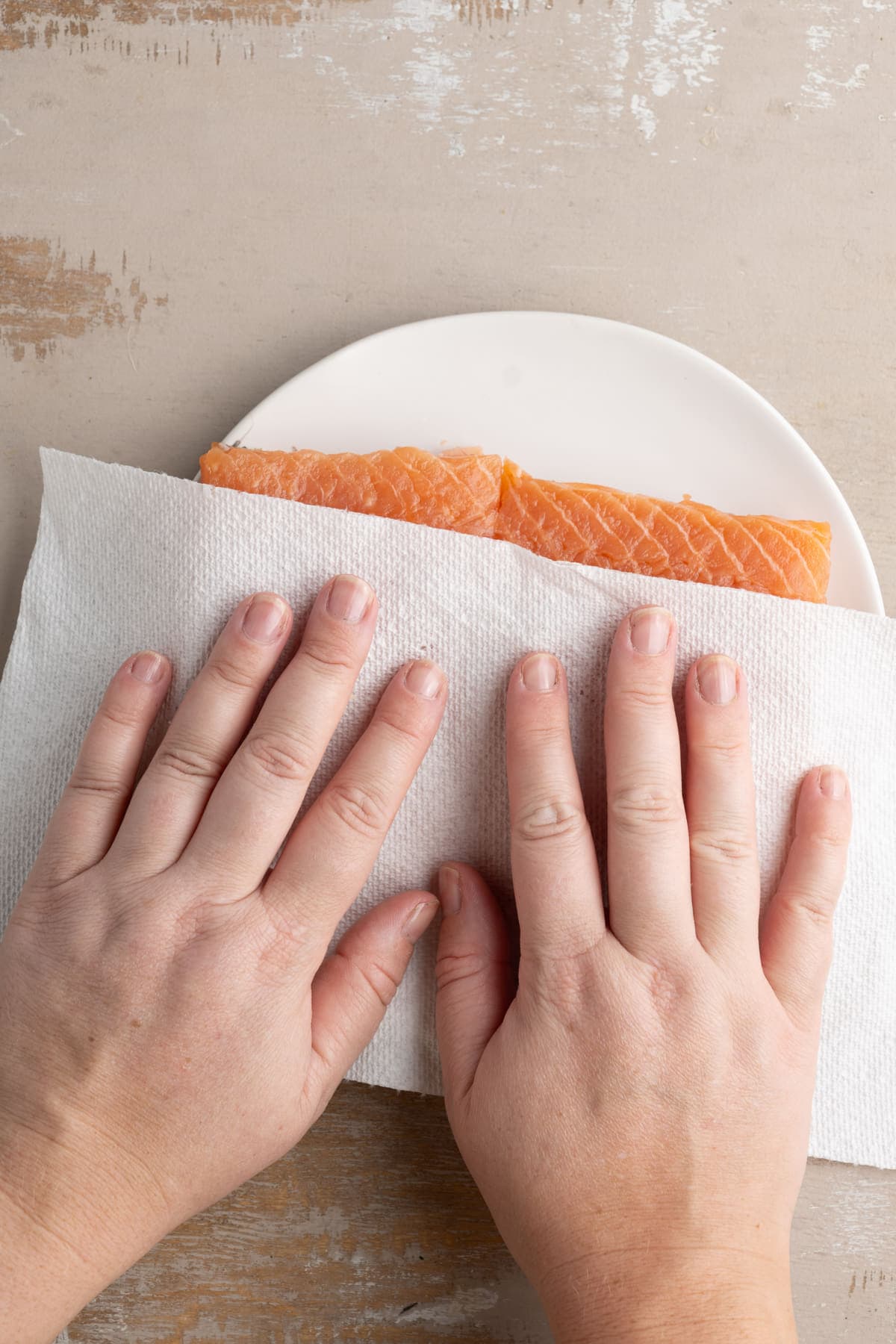
How to Easily Peel Garlic to Mince
In order to mince the garlic, you have to first peel it.
My preferred technique for easily peeling garlic is by gently crushing its outer layer. Using the flat end of a knife, apply pressure by using your bodyweight to push down on the garlic cloves until you hear them crunch.
With the outer layer now cracked, the peeling process becomes much easier. After peeling off the outsermost layer, arrange your garlic cloves on the cutting board.
Use a sharp knife to finely chop the peeled garlic, continuing to chop until the garlic is minced into small pieces. I love fresh garlic with salmon, just like in this Salmon Pesto Pasta.
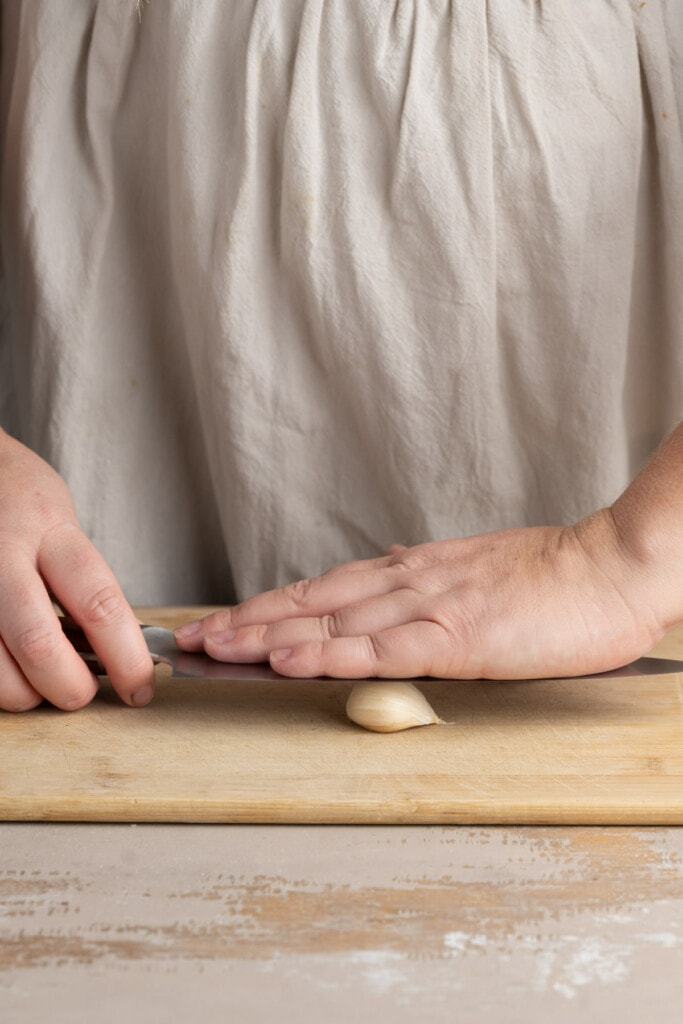
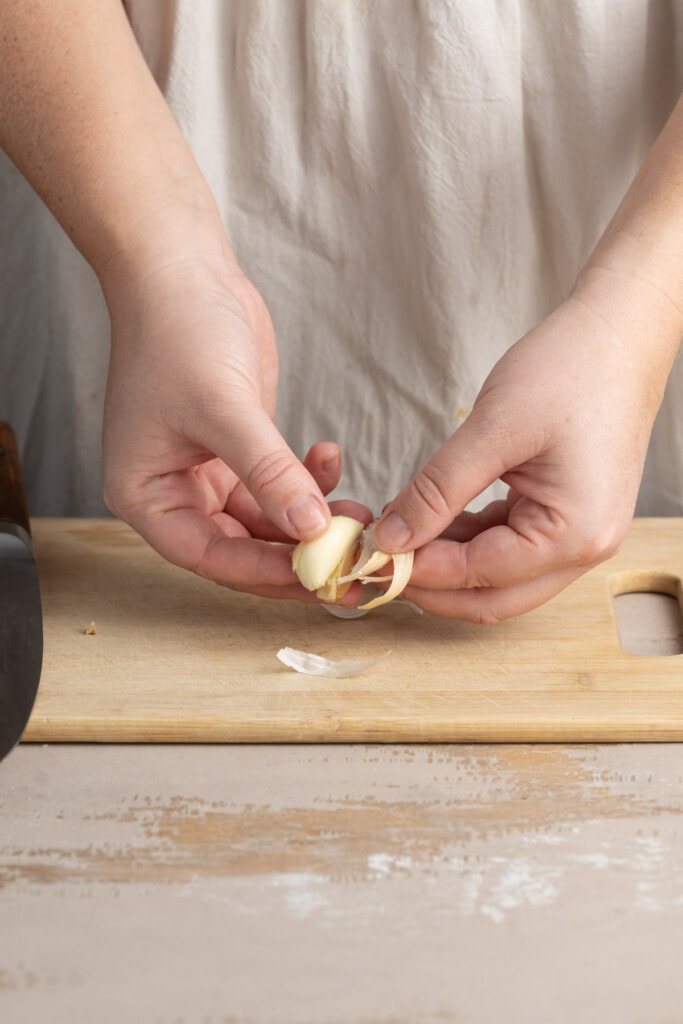
How to Prep Scallions for Salmon and Grits
For this recipe, we will be using the green and white part of the scallions. The white part is often tossed but contains so much flavor! Utilizing all parts of your veg is a great way to avoid food waste.
Rinse your scallions and slice off the “hairy” ends. These ends can be composted or saved with other veggie scraps to make your own vegetable broth.
Then, dice both the green and white parts of the scallion for your salmon dish.
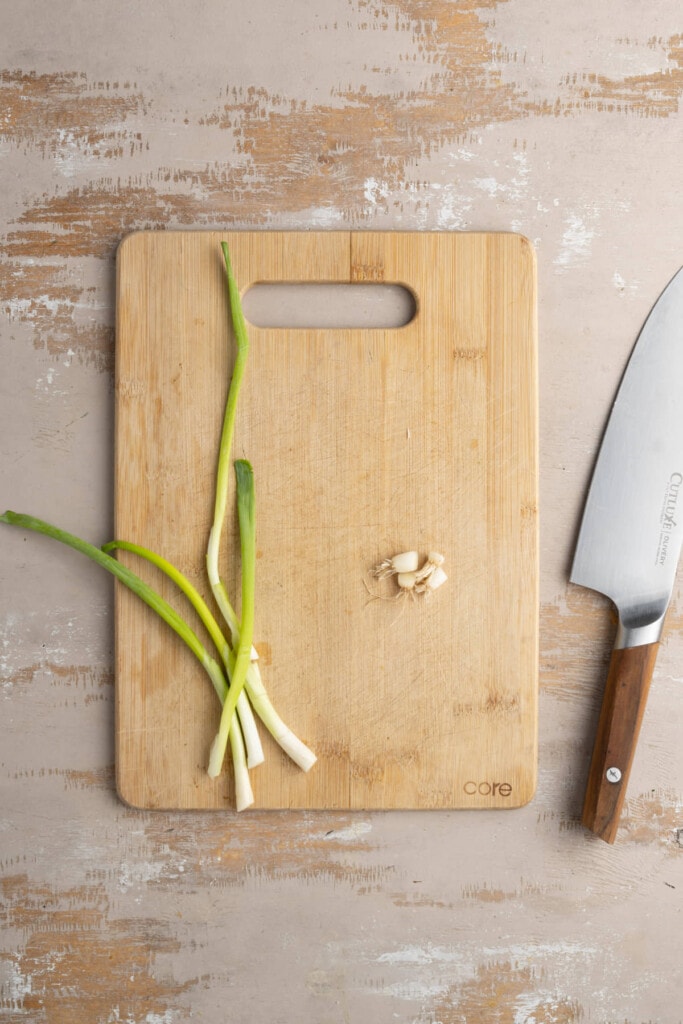
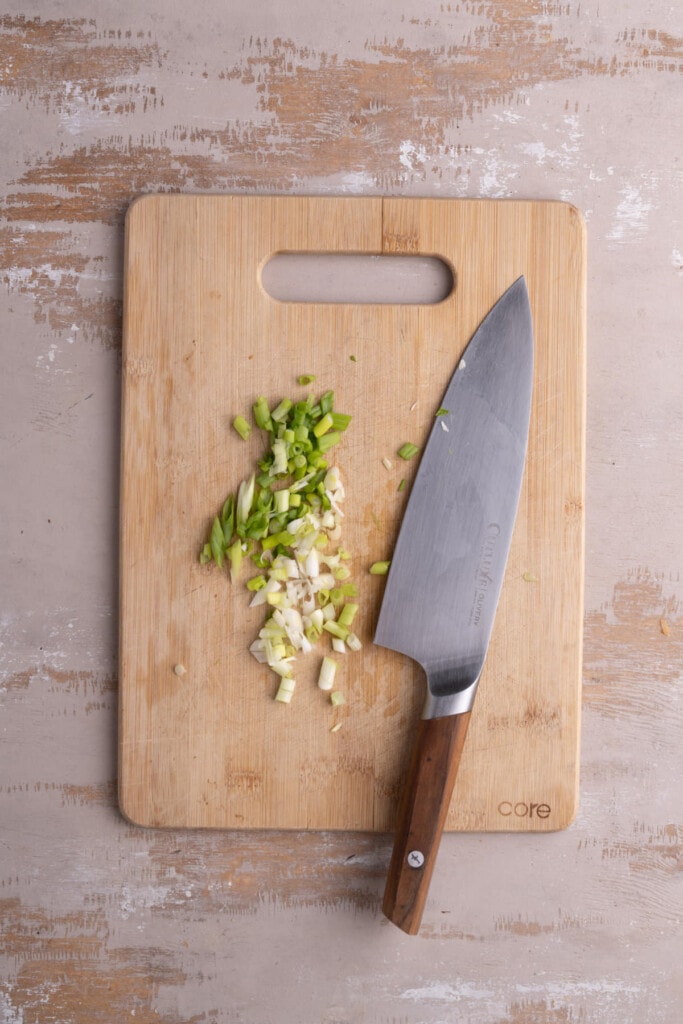
Cook the Grits in Vegetable Broth
Cooking the grits in vegetable broth rather than water infuses flavor into the grits, to start you off with a delicious base.
Add the vegetable broth and grits to a small pot fit with a lid. Bring to a boil, cover, and reduce the heat to low, so your grits and veggie broth are simmering.
Simmer for 5-7 minutes, stirring occasionally, until the grits soak up all the vegetable broth.
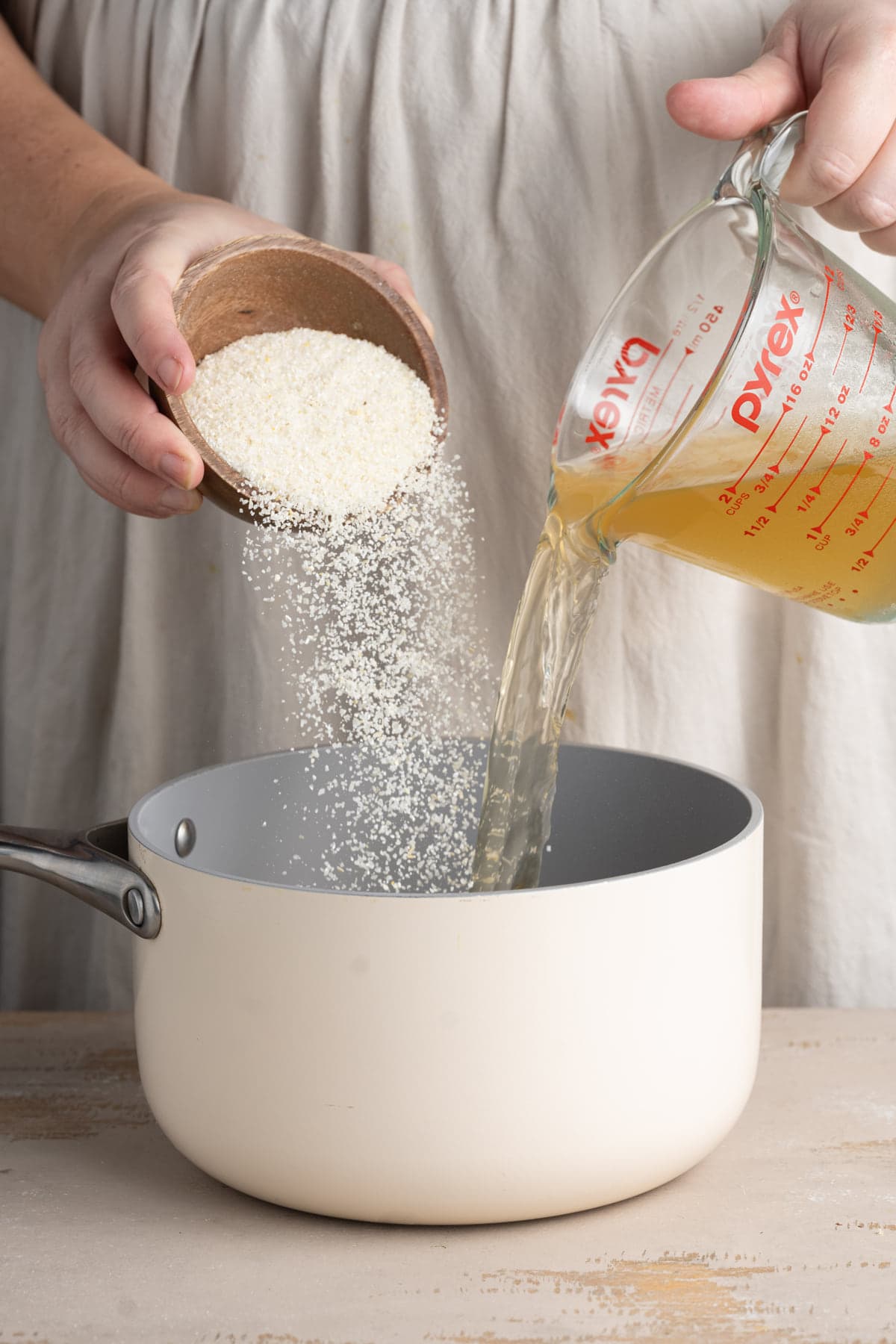
Add the Milk and Cheese Next
Once your grits are fully cooked in the vegetable broth, turn the stove off, but keep the pot on the burner. Add the milk and cheese and stir to combine, allowing the residual heat to melt the cheese.
At this point, your grits will be deliciously creamy and cheesy. Serve them up into two bowls, ready for your Cajun salmon on top!
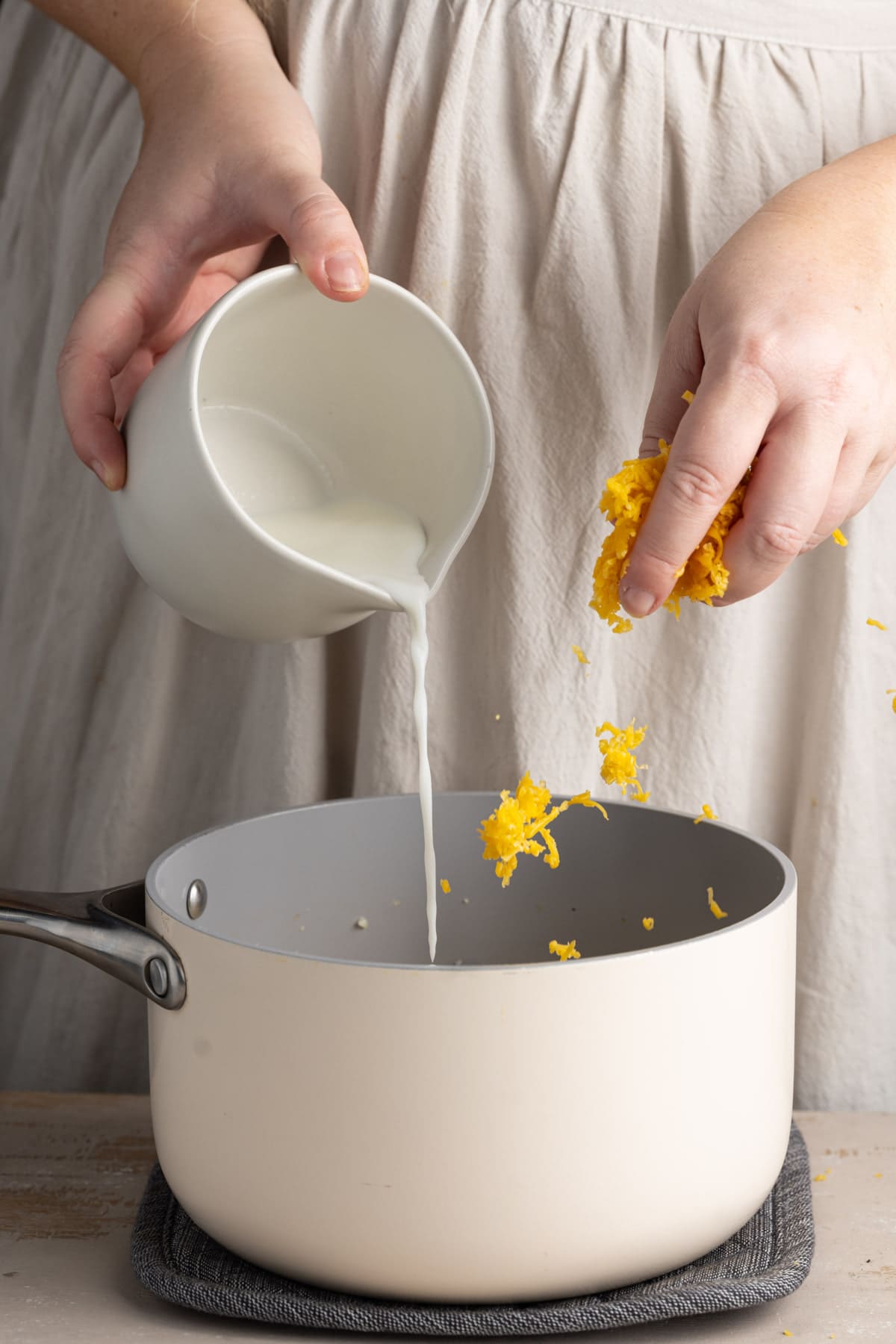
Get the Oil Hot in the Pan
While your grits are cooking, get the oil hot in a large pan. Turn your heat source up to medium, and allow the oil to heat up for two minutes before adding anything to the pan.
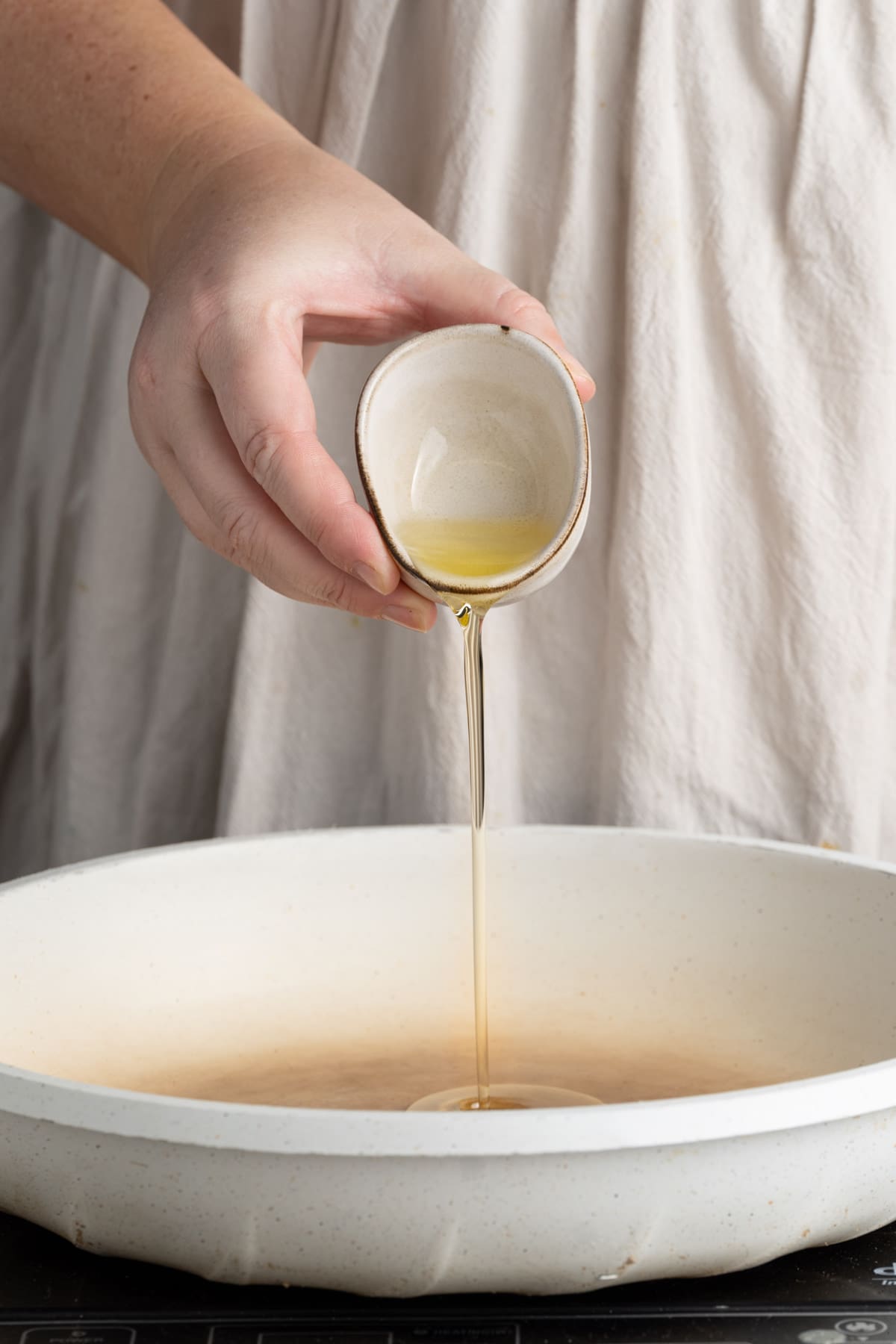
Season the Salmon in the Pan
Carefully add the garlic, shallots, and salmon to the pan. While the salmon is in the pan, add about half of the lemon juice and Cajun seasoning.
We are seasoning the salmon right in the pan so that any residual lemon juice or seasoning is captured and will be added back to the dish later.
Sear the salmon for 5 minutes and flip. Season the second side with the remaining Cajun seasoning and lemon juice. Sear for an additional 2-5 minutes on the second side.
Flip the salmon one last time just to lock in the seasonings. At this point, it’s the perfect time to take the temperature of your salmon. Ideally, we want the thickest part of the salmon to be somewhere between 125-145°F.
If it hasn’t reached 125°F, give it another couple of minutes and take the temperature again.

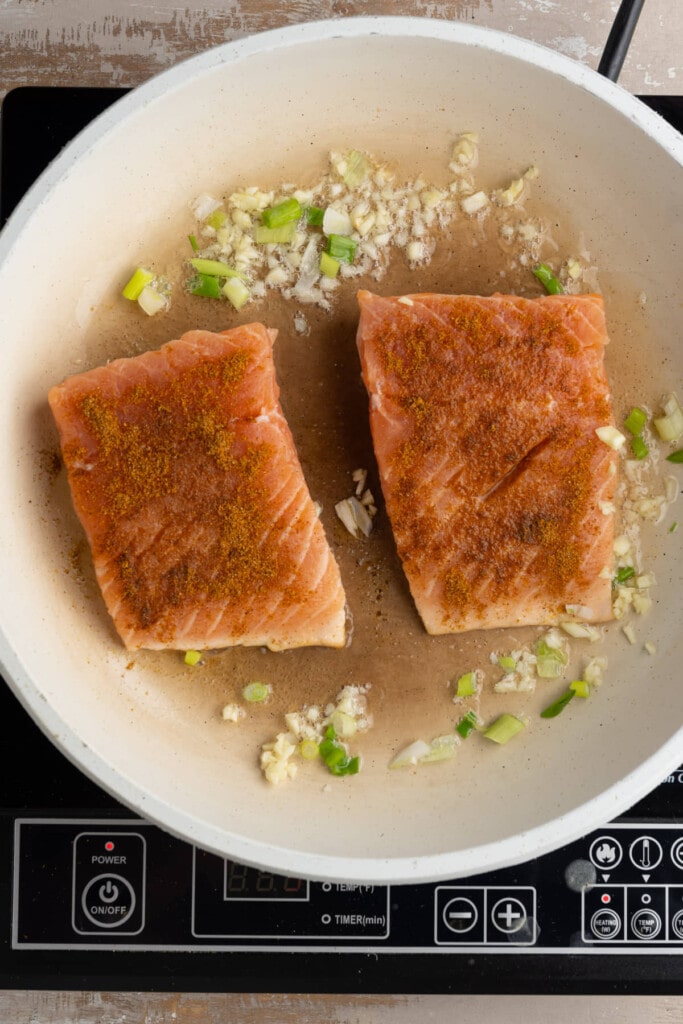
Deglaze the Pan with Butter
Once the salmon is fully cooked, remove it from the pan and place it right on top of your creamy grits.
Then, with the pan still over the heat, add the butter. Stir until the butter is completely melted and combines with the garlic, shallots, and remaining seasoning and lemon juice.
This will form an outrageously delicious butter-based sauce to complete your salmon and grits.
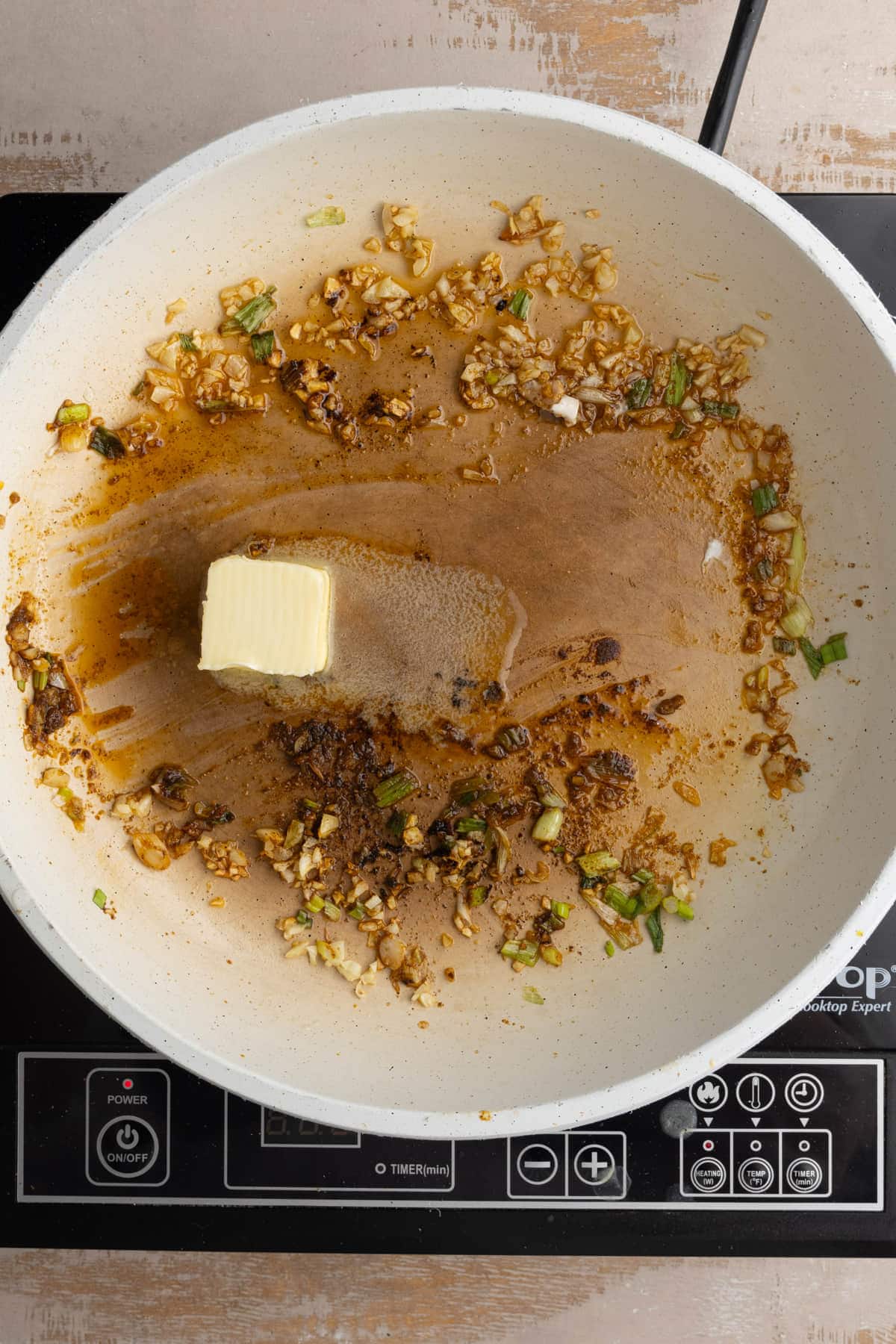
Serving Your Salmon and Grits
Once you’ve deglazed your pan to form a delicious butter sauce, drizzle it overtop your salmon and grits. This is a full meal on its own, but if you’re looking for some vegetable ideas to serve it up with, here are some of my favorites:
- Roasted Brussels Sprouts and Sweet Potatoes. A delightful blend of caramelized Brussels sprouts and tender sweet potatoes, roasted to perfection with simple seasonings and optional flavor-boosting add-ins.
- Roasted Broccoli and Carrots. Nutrient-packed broccoli and sweet, earthy carrots come together in this simple, flavorful roasted vegetable dish.
- Roasted Asparagus and Mushrooms. Tender asparagus spears and savory mushrooms unite in a fragrant medley, roasted to enhance their natural flavors.
- Sauteed Broccolini and Mushrooms. Broccolini and mushrooms sautéed to tender perfection, creating a harmonious balance of textures and tastes in this quick and healthy side dish.
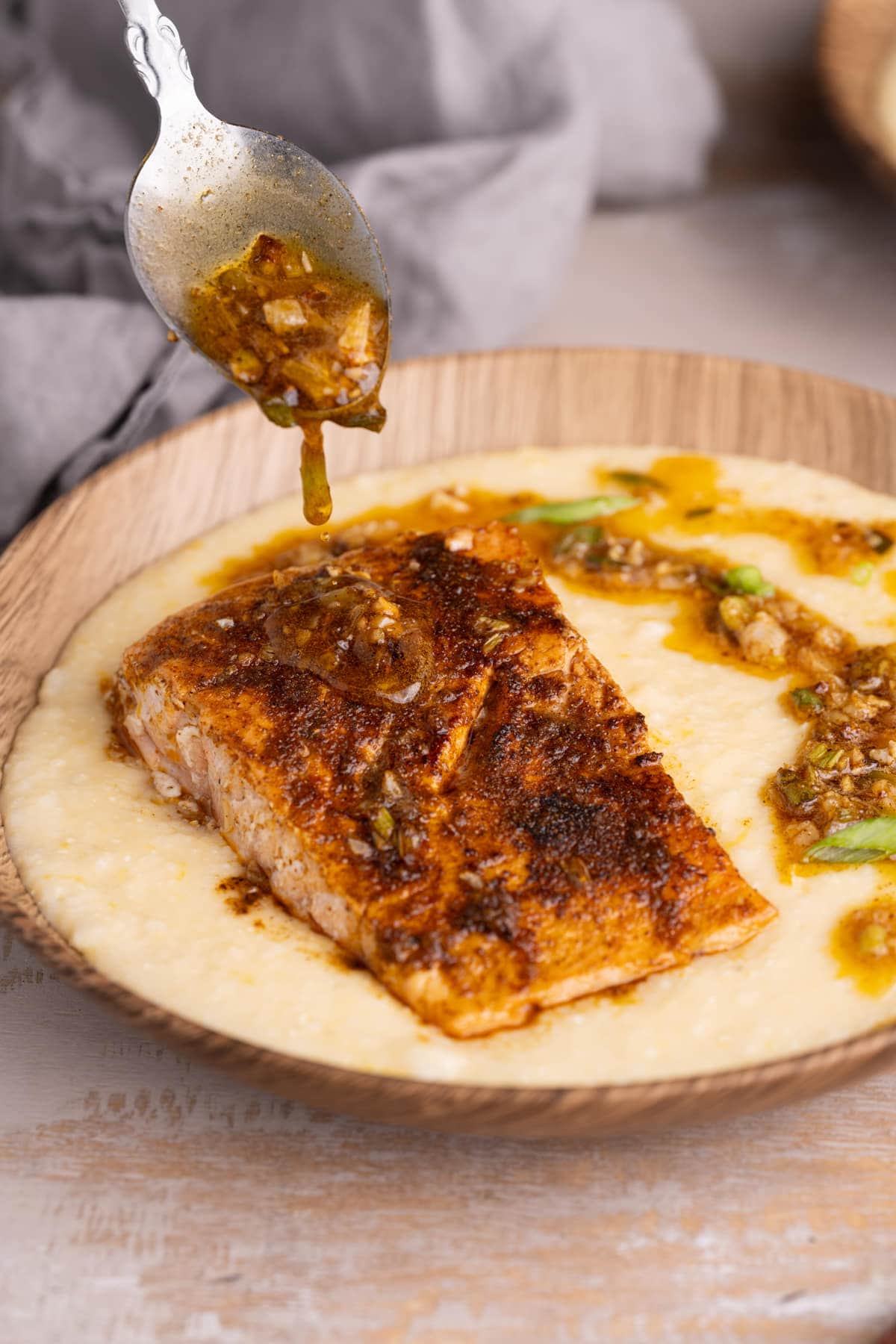
How to Properly Store and Reheat Leftover Grits with Salmon
Leftover pan-fried Cajun salmon will last in an airtight container in the refrigerator. The best way to reheat leftover salmon is in the oven.
Preheat the oven to 300°F and add the salmon to a baking sheet. Reheat it on the top rack for 15-20 minutes until the internal temperature of the salmon reaches 145°F.
As for the grits, you can reheat them over high heat on the stove or in the microwave on high for 3-5 minutes, stirring a couple times in between.
However you decide to reheat your grits, I recommend adding some extra vegetable broth or milk before reheating it. You will need about 2 tablespoons of liquid per serving of grits.
Green tip: Of the billions of tons of food wasted annually, 50% of food waste happens at home. Reduce your contribution to food waste by properly storing, reheating, and consuming leftovers.
Cajun Salmon and Grits Frequently Asked Questions
What is the secret to great grits?
The secret to great grits is cooking them in vegetable broth to infuse flavor. Then, if you want to make them nice and creamy, add milk and cheese after the grits are fully cooked in the veggie broth.
What is best to eat with grits?
Grits are commonly served as a breakfast food with eggs and/or breakfast meats like sausage and bacon. In the 1950’s in Charleston, shrimp and grits became extremely popular, shifting the mindset around grits and promoting it as more than just a breakfast food.
Since then, grits have been served for breakfast, lunch, and dinner, especially with seafood! Grits are delicious with not just shrimp, but salmon and other white fish as well.
Why You Should Make these Creamy Cajun Salmon and Grits
- The textures! Between the creamy grits and the crispy salmon, garlic, and shallots, this truly hits all the right notes.
- The flavors are bold. Between the Cajun seasoning, garlic, green onion, and lemon juice, this dish uses simple yet impactful ingredients to bring bold flavor.
- It comes together quickly! The grits come together in 10-15 minutes as does the salmon! After making this recipe a couple of times and getting the hang of it, you can truly get it on the table in 20 minutes or less!
If you’re loving this Creamy Cajun Salmon and Grits and want more seafood dinners, check out this Blackened Shrimp & Old Bay-Seasoned Mashed Potatoes and Salmon Spinach Pasta with White Wine Sauce.
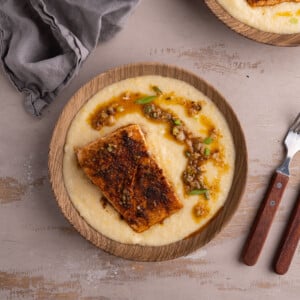
Creamy Cajun Salmon and Grits
Equipment
Ingredients
Creamy Grits
- ½ cup quick grits
- 2 cups vegetable broth
- ⅓ cup milk (any dairy or unsweetened non-dairy)
- ¼ cup medium or sharp cheddar cheese (¼ cup shredded = approx. 2 ounces)
Cajun Salmon and Butter Sauce
- 2 tablespoon olive oil
- 10 ounces skinless salmon (in 2 individual 5 ounce portions)
- 4 scallions (aka green onion)
- 4 cloves garlic
- 1 tablespoon lemon juice
- 2 teaspoons Cajun seasoning
- 2 tablespoons unsalted butter
Instructions
Creamy Grits
- In a small pot fit with a lid, add the grits and vegetable broth and bring to a boil. Reduce heat to low and cover, simmering for 5-7 minutes until the mixture thickens.
- Then, turn the heat source off but keep the pot on the burner. Add the milk and cheddar cheese and whisk to combine, using the residual heat to melt the cheese.
- Split the creamy grits into two equal servings in a shallow bowl.
Cajun Salmon and Garlic and Shallot Deglaze
- To a large saucepan over medium heat, add the olive oil and get it hot for 2 minutes.
- Prep your salmon by using a paper towel to pat it dry (try these bamboo paper towels for a more sustainable option!) At this time, remove the skin and slice into two equal portions if necessary.
- Peel and mince your garlic and dice your shallots.
- Add the garlic and shallots to the hot oil and carefully lower your salmon into the pan. With the salmon in the pan, add about half of the Cajun seasoning and lemon juice on top. Seasoning the salmon while it's in the pan will ensure we make the most of both the Cajun seasoning and the lemon juice when we deglaze the pan later.
- Sear the salmon for 5 minutes and flip. Season the second side with the remaining Cajun seasoning and lemon juice. Sear for an additional 2-5 minutes on the second side.
- Flip the salmon one more time and use a spatula to quickly press the salmon into the pan, just to lock the seasoning onto the salmon. Check the internal temperature of the salmon. We are aiming for 125-145°F.
- Remove the salmon from the pan and place it right on top of the grits. Add the butter to the pan with the garlic, shallots, and excess seasoning and lemon juice to deglaze the pan.
- Drizzle the shallot and garlic butter on top of the salmon and grits and enjoy.
Pro Tips
- I use quick grits, mostly because they’re more widely available and easier to find, but also because it helps me get this meal on the table fast. If you prefer stoneground or Old Fashioned grits, they absolutely work in this recipe, too. You will just need to leave them over the heat a little bit longer.
- You can use fresh salmon or thawed frozen salmon.
- If you like salmon, you’ll love this collection of my best salmon recipes!
Video
Share This Recipe
